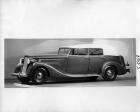|
Re: Torsion level suspension
|
||||
|---|---|---|---|---|
|
Home away from home
|
Dwight Heinmuller sells the bushing kits and has reproductions of the factory tool needed to install them but I don't recall his site mentioning anything about them stopping the car from leveling itself unexpectedly. That would clearly be an electrical issue.
Posted on: 1/2 18:45
|
|||
|
||||
|
Re: Torsion level suspension
|
||||
|---|---|---|---|---|
|
Forum Ambassador

|
Nice looking test box. Not sure how it works, but guessing it allows you to monitor circuits in action, following tests outlined in factory service info. If successful, might be something worth duplicating for resale.
Posted on: 1/2 21:26
|
|||
|
||||
|
Re: Torsion level suspension
|
||||
|---|---|---|---|---|
|
Home away from home
|
Yes, I agree and would love to have one myself!
Posted on: 1/2 22:20
|
|||
|
||||
|
Re: Torsion level suspension
|
||||
|---|---|---|---|---|
|
Home away from home

|
I am not to sure on the price of doing this job, but Ross Miller at Speedwell garage (in Parkton Maryland, not that far from you) works on these cars and does a really good job. He replaced the bushings in the family's 56 Caribbean and it rides better than it ever has since I remember riding in it as a kid. It doesnt stay level while driving, but I think that is because the upper bump stops on the front are missing.
I did replace all the bushings on my 56 Patrician and that car rides like a dream. Only time it levels it self is when there is a weight change in the car (added gas, or people) or if I raised the car off the ground to the point the wheels leave the ground. It seems any time the system is unloaded from the car's weight it needs to settle back out by pushing on the front or rear bumper once it is back on the ground. Other suggestions of making sure your generator and voltage regulator are in good shape is another good suggestion.
Posted on: 1/3 10:43
|
|||
|
||||
|
Re: Torsion level suspension
|
||||
|---|---|---|---|---|
|
Home away from home
|
Yes fainacci, can you explain a bit the operation of that test box? Did you make it specifically for testing the torsion level system?
Posted on: 1/3 11:01
|
|||
|
'55 400. Needs aesthetic parts put back on, and electrical system sorted.
'55 Clipper Deluxe. Engine is stuck-ish. |
||||
|
||||
|
Re: Torsion level suspension
|
||||
|---|---|---|---|---|
|
Home away from home
|
Do you still have the problem you described as "Often when driving the front or rear end would raise or lower for no apparent reason. But, it always returned to level."?
Have you tested the delay time?
Posted on: 1/4 14:17
|
|||
|
||||
|
Re: Torsion level suspension
|
||||
|---|---|---|---|---|
|
Home away from home
|
Here is a quick description of the features, functions, and tests of the test box:
Torsion Level Test Box Switches and indicators: Up and Down arrow indicators: Lights when the Compensator Control/Delay Switch engages one of the direction relays and the contacts successfully close sending a signal to the limit switch. Limit indicator: Lights when the direction relay is sending a signal to the Limit switch and the Limit switch is not sending the signal to the solenoid switch. Motor indicator: Lights when the solenoid switch is closed and sending a power to the Compensator motor. Delay display: Displays the number of seconds the Compensator Control/Delay Switch has delayed engaging the direction relay. The delay count begins when the Compensator Control/Delay Switch contacts close and current is drawn and ends when the direction relay contacts close. The Delay display works for Out of car Mode tests and for Automatic IN car Mode tests Power indicator: Lights when the test box power is switched on and the test box has power. Reset button: Resets the Delay display counter to zero. Brake indicator: Lights to indicate that the brake light switch has interrupted the power to the Compensator Control/Delay Switch. This indicator also lights when the torsion level manual switch is turned off and when the manual level control switch is operated. Power switch: Turns the power to the text box on and off. Mode switch: Switched between out of car testing of the Compensator Control/Delay Switch and in case testing of all of the suspension components. Up/Down switch: Signals the solenoid switches to run the Compensator Up or Down. This switch only operates in In Car Mode with the Man/Auto switch set to Manual. Bypass/Limit switch: Routes the Up/Down switch signals to the solenoid switched either with or without the use of the limit switches. Amps display: Shows the total current in use by the torsion level control circuits. This includes the delay, direction relay and solenoid switch. Man/Auto switch: Selects between the Compensator Control/Delay Switch and the manual Up/Down switch for signaling the solenoid switches to operate the compensator. Connections: 1. 12 volt DC power supply to run the test box. Clips to attach to a source in the car. 2. Connects to all the connectors in the 56 Compensator Control/Delay Switch. All of the harness connectors connect to the test cable. 3. Ground clip for the Compensator Control/Delay Switch 3. Clips to attach to the solenoid switch outputs Tests: Two test modes: 1. Out of car: tests the Compensator Control/Delay Switch 2. In car: Tests the Compensator Control/Delay Switch, limit switches, solenoid switches, and compensator motor. Out of car tests: Connect the test box: 1. Connect the test cable Green, Yellow, and Pink wires with the male bullet connectors to the Compensator Control/Delay Switch 2. Connect the black ground clip to the Compensator Control/Delay Switch 3. Connect the test box to a 12 volt DC source using the Red and Black clips Test the Compensator Control/Delay Switch out of the car: 1. Turn on the test box. 2. Set the MODE switch to OUT. 3. Move the Compensator Control/Delay Switch lever to one side. If the delay timer contacts and heating element work, the ammeter will display the current drawn by the timer and the delay display will show the delay time in seconds. If the delay timer completes the delay, it will engage the compensator direction relay. If the relay coil works, the ammeter will show an increased current draw. If the compensator direction relay works, you will hear it “click” and the direction indicator will light. Otherwise the ammeter will show the increased current value and the delay display will continue to count delay seconds Otherwise the ammeter will remain the same and the delay display will continue to count delay seconds. Otherwise the ammeter will remain the same and the delay display will continue to count delay seconds. Otherwise the ammeter and delay display will show 0. 4. To test the other direction, move the Compensator Control/Delay Switch lever to the neutral position, reset the delay display with the RESET button and move the Compensator Control/Delay Switch lever to the other side. In car tests: Connect the test box: 1. Connect the test cable Green, Yellow, and Pink wires with the male bullet connectors to the Compensator Control/Delay Switch. 2. Connect the wiring harness Green, Yellow, and Pink wires with the male bullet connectors to the test cable Green, Yellow, and Pink wires with the female bullet connectors. 3. Connect the wiring harness Orange wire and the Up limit switch Orange wire to the test cable Orange wire. 4. Connect the wiring harness Blue wire and the Down limit switch Blue wire to the test cable Blue wire. 5. Connect the black ground clip to the Compensator Control/Delay Switch 6. Connect the clips on the test box Red and Brown wires to the solenoid switches Red and Brown wire connections. 7. Connect the test box to a 12 volt DC source using the Red and Black clips To test the Fuse, Brake Light Switch, Torsion Level On/Off Switch, and the optional Manual Level Switch (For each of these tests we assume that the other three functions are working): 1. Turn on the test box. 2. Set the MODE switch to IN. 3. Fuse test: If the Brake light is lit, there is no power to the Compensator Control/Delay Switch Green wire and the fuse is bad. 4. Brake Light Switch test: Press the brake pedal If the Brake Light Switch works, the Brake light will light. 5. Torsion Level On/Off Switch test: Turn the Torsion Level On/Off Switch Off If the switch works, the Brake light will light. Turn the Torsion Level On/Off Switch On If the switch works, the Brake light will go out. 6. Manual Level Switch test Move the Manual Level Switch to the lower position. If the Manual Level Switch works, the Brake light will light. Move the Manual Level Switch to the raise position. If the Manual Level Switch works, the Brake light will light. Test the Compensator Control/Delay Switch in the car: 1. Turn on the test box. 2. Set the MODE switch to IN. 3. Set the AUTO/MAN switch to AUTO 4. Load or unload the car so it is not level. If the delay timer contacts and heating element work, the ammeter will display the current drawn by the timer and the delay display will show the delay time in seconds. If the delay timer completes the delay, it will engage the compensator direction relay. If the relay coil works, the ammeter will show an increased current draw. If the compensator direction relay works, you will hear it “click” and the direction indicator will light. Otherwise the ammeter will show the increased current value and the delay display will continue to count delay seconds Otherwise the ammeter will remain the same and the delay display will continue to count delay seconds. Otherwise the ammeter will remain the same and the delay display will continue to count delay seconds. Otherwise the ammeter and delay display will show 0. 5. To test the other direction, move the Compensator Control/Delay Switch lever to the neutral position, reset the delay display with the RESET button and move the Compensator Control/Delay Switch lever to the other side. Test the complete suspension under the control of the Compensator Control/Delay Switch: 1. Execute the Compensator Control/Delay Switch in the car test. 2. From the successful completion of the four tests in step 4: If the Solenoid switch coil works, the ammeter will show an increased current draw. If the solenoid switch works, you will hear it “click” and the motor indicator will light for the direction. If the leveling motor works, it will run. If the leveling mechanicals work, the car will level. If the car reaches the limit for travel in that direction, the Limit Switch will disable the solenoid switch, the motor will stop, the Motor light will go out, and the Limit light will light. Otherwise If the car reaches the level position, the Compensator Control/Delay Switch contacts will disengage, the delay will disengage, the direction relay will disengage, the solenoid switch will disengage, the motor will stop, the direction and motor lights will go out and the ammeter will go to zero. The Delay display will show the delay time until the RESET button is pressed. Otherwise it the Compensator continues to run without reaching level or the limit in that direction, damage may occur. Otherwise the Compensator will work against the mechanical problem and damage may occur. Check the Compensator gear box and links. Otherwise the Compensator motor will not run. Check the Compensator motor. Otherwise nothing will happen. The coil energizes, but the contacts do not engage. Check the Solenoid switch. Otherwise nothing will happen. The coil does not energize. Check the Solenoid switch Test the suspension manually without the Compensator Control/Delay Switch: 1. Turn on the test box. 2. Set the MODE switch to IN. 3. Set the AUTO/MAN switch to MAN 4. To include the Limit switches in the test set the BYPASS/LIMIT switch to LIMIT 5. To raise the car press UP on the UP/DOWN switch The UP light will light Continue from step 2 of “Test the complete suspension under the control of the Compensator Control/Delay Switch:” 6. To lower the car press DOWN on the UP/DOWN switch 7. To exclude the Limit switches from the test set the BYPASS/LIMIT switch to BYPASS The UP light will light Continue from step 2 of “Test the complete suspension under the control of the Compensator Control/Delay Switch:” 8. To exclude the Limit switches in the test set the BYPASS/LIMIT switch to BYPASS WARNING: CARE MUST BE TAKEN WHEN OPERATING THE COMPENSATOR WITHOUT THE LIMIT SWITCHES AS MECHANICAL DAMAGE MAY OCCUR! 9. To raise the car press UP on the UP/DOWN switch The UP light will light Continue from step 2 of “Test the complete suspension under the control of the Compensator Control/Delay Switch:” 10. To lower the car press DOWN on the UP/DOWN switch 11. To exclude the Limit switches from the test set the BYPASS/LIMIT switch to BYPASS The UP light will light Continue from step 2 of “Test the complete suspension under the control of the Compensator Control/Delay Switch:”
Posted on: 1/4 14:20
|
|||
|
||||
|
Re: Torsion level suspension
|
||||
|---|---|---|---|---|
|
Forum Ambassador
|
Quote:
The how it works question is answered but I am also curious about who made it or where the box comes from.
Posted on: 1/4 15:17
|
|||
|
Howard
|
||||
|
||||
|
Re: Torsion level suspension
|
||||
|---|---|---|---|---|
|
Home away from home
|
Howard,
I built the test box. The last time I replaced a Compensator Control/Delay Switch, I bench tested it manually. I was glad I did as I found a stuck relay which I fixed prior to installation. Last year I was driving a friend's Clipper and identified an approximately 0 second delay. He got a NOS Compensator Control/Delay Switch which I suggested be tested before installation. This got me thinking that there should be a better way to test it. So I decided to build one. It started as a tester for the Compensator Control/Delay Switch out of the car and I kept adding functions.
Posted on: 1/4 16:52
|
|||
|
||||

 IMG_0756.jpeg (3,639.89 KB)
IMG_0756.jpeg (3,639.89 KB)








